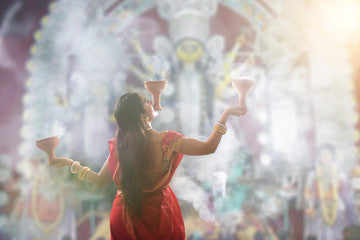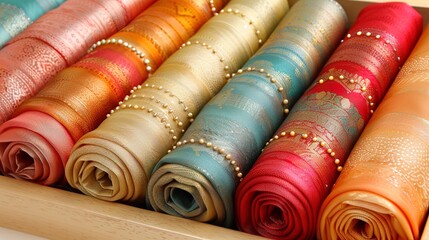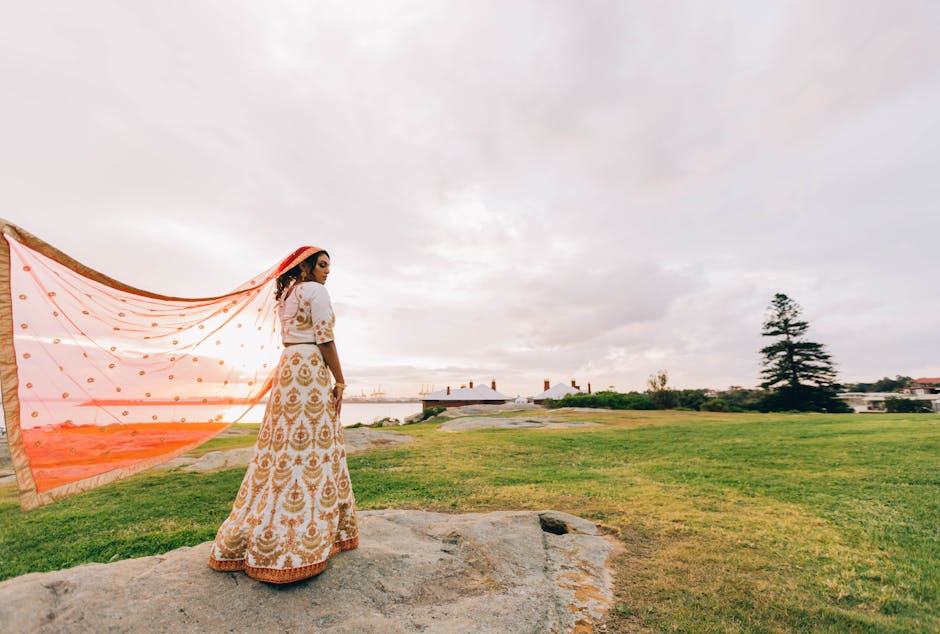How to Identify Authentic Dhakai Saree: Tips from the Experts
Introduction to Dhakai Saree
Dhakai saree, originating from Bangladesh, is a symbol of elegance and tradition. Known for its delicate weaving and intricate designs, this saree is a must-have in the wardrobe of those who appreciate craftsmanship and cultural heritage. Dhakai sarees are typically made from cotton or silk, making them perfect for various occasions, from casual outings to grand weddings. What sets them apart is the meticulous detail and the effort that goes into creating each piece. It takes skilled artisans days, sometimes even weeks, to weave a single saree, highlighting the dedication behind these masterpieces. Whether it’s the classic Muslin Dhakai, known for its fine texture and luxurious feel, or the Jamdani, renowned for its artistic motifs and durability, each Dhakai saree tells a story of artistry and tradition. Understanding the value and beauty of Dhakai sarees opens up a world of elegance that transcends mere fashion, embracing a rich cultural legacy.
The rich history behind Dhakai Saree
The Dhakai Saree hails from Bangladesh, originating from Dhaka, hence the name. This masterpiece has a history that stretches back centuries, to the Mughal era, making it not just a piece of clothing but a symbol of rich tradition and culture. Traditionally, these sarees were made from muslin, famously known for its exceptional delicacy and intricate weaving. This craft flourished under the patronage of Mughal emperors who prized the fine muslin for its lightness and almost transparent quality. Over time, the art of Dhakai weaving faced challenges, especially during the British colonial rule when cheaper, machine-made fabrics flooded the market. However, the dedication of local weavers and artisans in Bangladesh has kept this traditional art alive. Today, while authentic Dhakai Sarees continue to honor their rich heritage, they also embrace contemporary designs, making them timeless pieces of clothing cherished all over the world. Remember, every thread in a Dhakai Saree weaves together history, culture, and the unbreakable spirit of its people.
Key features of an authentic Dhakai Saree
When you’re hunting for an authentic Dhakai Saree, there’re a few key features you gotta focus on. First up, the material. A genuine Dhakai Saree is made from either pure cotton or silk, making it not just beautiful but also comfortable to wear. Now, let’s talk craftsmanship. The real deal showcases fine, intricate patterns that are woven into the fabric, not printed or embroidered. This is a labor of love, folks — it means each saree can take months to create.
Next on the list is the feel of the saree. Authentic Dhakai has a soft, delicate texture that’s hard to miss. It’s lightweight, making it perfect for any occasion. Also, pay attention to the edges. The borders and ends of a true Dhakai Saree are neatly finished, featuring detailed motifs that speak volumes of its quality.
Color play is another giveaway. These sarees often flaunt a harmonious blend of vibrant hues, achieved through traditional dyeing processes. And last but not least, the price tag. Quality craftsmanship comes at a cost, so if the price seems too good to be true, it probably is.
Remember, an authentic Dhakai Saree is not just a piece of clothing; it’s a work of art that carries the essence of rich cultural heritage. Keep these pointers in mind, and you’ll be able to spot the real deal from a mile away.
Common materials used in Dhakai Saree
Dhakai Sarees, straight from Bangladesh’s heart, Dhaka, are prized for their intricate weaving and delicate designs. Let’s talk materials - they’re key to spotting an authentic piece. The real deal Dhakai Saree primarily uses cotton and silk. In the beginning, artisans would weave these sarees using the finest muslin, a cotton fabric so light and airy, it was called the “woven air” by many. Over time, silk threads started to weave their way into the craft, introducing variations like silk muslin, famously known as Silk Dhakai. Another member of the Dhakai family is Jamdani, a term that speaks volumes about craftsmanship, where cotton and silk merge in patterns so detailed, they seem painted on. So, when you’re out there hunting for an authentic Dhakai Saree, remember: the magic is in the material—cotton for that feather-light feel, silk for the luxurious sheen, or the best of both in Jamdani. Keep it simple, keep it authentic.
Expert tips for identifying an authentic Dhakai Saree
Dhakai sarees, originating from Bangladesh, are famous for their unique craftsmanship and delicate threadwork. Recognizing an authentic Dhakai can be tricky, so here are some tips straight from the experts. Look closely at the fabric; authentic Dhakai sarees are handwoven with fine muslin cloth, making them extremely soft and delicate. Check the patterns and motifs. The designs on a genuine Dhakai are intricate and detailed, often featuring floral or geometric shapes that are evenly spaced and clearly defined. Feel the weight. Despite their fine appearance, Dhakai sarees have a bit of heft due to the density of the handwoven fabric. Lastly, the price tag is a giveaway. True Dhakai sarees won’t come cheap because of the meticulous work involved in their creation. If you stumble upon a bargain deal, scrutinize it further. Keep these pointers in mind, and you’ll be able to spot an authentic Dhakai saree.
The importance of weave and pattern in authentication
When you’re hunting for an authentic Dhakai saree, the weave and pattern aren’t just details—they’re the heart of the saree’s identity. Dhakai sarees, originally from Bangladesh, are famed for their intricate weaving and delicate patterns. To spot the real deal, focus on the fabric’s texture and the design’s complexity. Authentic Dhakai sarees have a fine, yet robust, mesh-like texture, a testament to their high-quality handweaving process. The patterns, often inspired by nature, are meticulously detailed, with no two sarees being exactly alike.
Look for the signature motifs like floral designs, geometric patterns, and the buti, small, scattered motifs. These designs should be evenly spaced and intricately executed. If the saree features overly simplistic patterns or the fabric feels stiff and machine-made, chances are it’s not an authentic Dhakai. Remember, the beauty of an authentic Dhakai saree lies in its sophisticated weave and the subtlety of its patterns. So, paying attention to these aspects can help you distinguish a genuine piece from a counterfeit one, ensuring you get your hands on a saree that’s worth every penny.
Signs of imitation Dhakai Sarees
Spotting fake Dhakai Sarees isn’t too hard once you know what to look for. First up, check the price. Authentic Dhakai Jamdani sarees are usually expensive due to the meticulous craftsmanship involved. If it’s cheap, think twice. The weave is another giveaway. Genuine Dhakai sarees have an intricate weave that’s hard to replicate by machines. Imitations often have a simpler, more uniform pattern. Touch and feel the fabric. Real Dhakai is lightweight and soft, whereas fakes might feel stiffer or rougher. Lastly, take a close look at the motifs. In authentic sarees, motifs are well-defined and woven into the fabric, not printed or embroidered on top. Always buy from reputable sellers, and don’t hesitate to ask for authenticity certificates if available.
Where to buy authentic Dhakai Sarees
Finding a real Dhakai Saree is all about knowing where to look. Dhakai, originally from Bangladesh, specifically Dhaka, has found its way into markets all over. For authenticity, aim for reputable stores or markets in Bangladesh. Cities like Dhaka and Khulna have shops teeming with genuine Dhakai Sarees. But, it’s not just Bangladesh; major Indian cities like Kolkata also have trusted vendors dealing in authentic Dhakai. Online, tread carefully. Choose well-known platforms with positive reviews and check for seller authenticity. Remember, a real Dhakai Saree is a blend of tradition and craftsmanship, so it might command a higher price but it’s worth every penny for its quality and heritage.
How to maintain the quality of your Dhakai Saree
To keep your Dhakai saree looking as splendid as it did when you first laid eyes on it, you’ll need to show it some tender love and care. Here’s how: First off, always store your Dhakai saree separately in a soft muslin cloth. This prevents any color bleed from other fabrics and keeps those delicate threads safe. It’s tempting to just toss it in the washing machine, but that’s a big no-no. Hand wash your saree gently with mild detergent and cool water. Avoid wringing it out too harshly; instead, softly squeeze out the excess water. Don’t make the mistake of drying it under harsh sunlight. Lay it flat in a shady spot for drying to keep its colors vibrant. And when it comes to ironing, low heat is the way to go and always use a protective cotton cloth over it. If you notice a pesky stain, resist the urge to scrub. Take it to a professional cleaner who knows their way around delicate clothes. Remember, a Dhakai saree isn’t just fabric; it’s a masterpiece. Treat it like one.
Summary and final thoughts on selecting a genuine Dhakai Saree
Selecting a genuine Dhakai Saree is all about paying attention to the details. Remember, true Dhakai Jamdani is handwoven, showing off craftsmanship that’s hard to replicate by machines. Here’s what you should keep in mind: the fabric should have a soft feel, and the patterns should be intricate, with no loose threads. Don’t go just by the price tag; even though authentic ones tend to be pricier, high price doesn’t guarantee authenticity. Always buy from a reputable seller, and if possible, get a recommendation from someone experienced. Lastly, trust your senses. A real Dhakai Saree speaks to you not just through its look but its entire make-up. Taking these tips to heart, you’re now armed to pick a genuine Dhakai Saree that not only captivates with its beauty but also carries a piece of cultural heritage.






